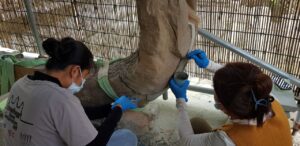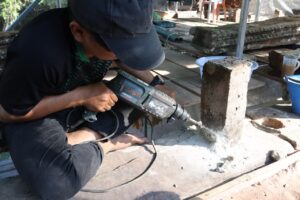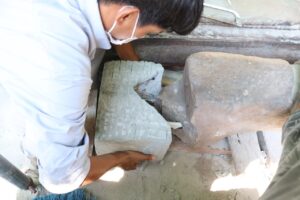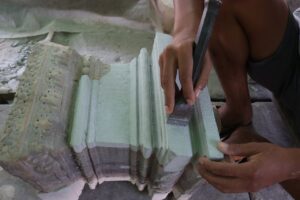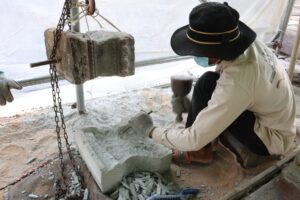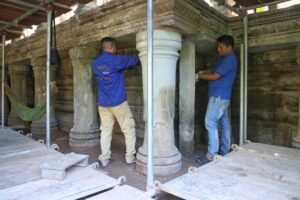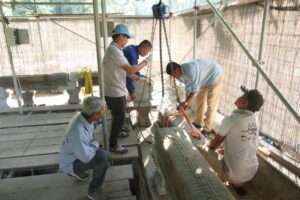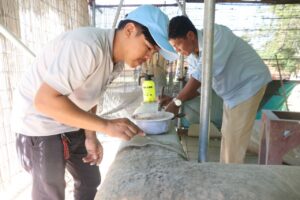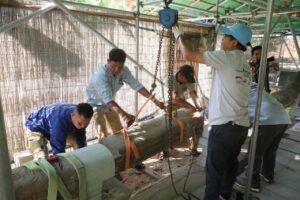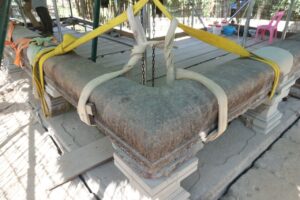ការងារជួសជុលរចនាសម្ពន្ធរបស់រានហាលនៅទិសខាងកើតប៉ែកខាងជើងនៃប្រាសាទបន្ទាយសំរ៉ែ ផ្នែកខាងលិចជណ្ដើរ ដែលចាប់ផ្ដើមតាំងតែពីកំឡុងខែមករា រហូតមកដល់ពេលនេះ បានសម្រេចបានប្រមាណ៩០ភាគរយ គ្រោងនឹងបញ្ចប់នៅចុងឆ្នាំ២០២៤ខាងមុខនេះ។
លោក ឡុង ណារី អ្នកជំនាញអភិរក្សថ្មនៃនាយកដ្ឋានអភិរក្សប្រាសាទ និងបុរាណវិទ្យា ឱ្យដឹងថា ការងារជួសជុលរចនាសម្ពន្ធរានហាលនៅទិសខាងកើតប៉ែកខាងជើងនៃប្រាសាទបន្ទាយសំរ៉ែ ផ្នែកខាងលិចជណ្ដើរ បានចំណាយពេលជិត១ឆ្នាំ ដោយត្រូវសិក្សាបន្ថែម និងស្វែងរកបំណែកថ្មនៃបង្កាន់ដៃនាគដើម្បីយកមកជួសជុលឡើងវិញ ដោយសារតែរចនាសម្ពន្ធនៃរានហាលមានសភាពទ្រុឌទ្រោមខ្លាំង ដូចជា សសររបស់រានហាលពុកផុយ ចម្លាក់បង្កាន់ដៃនាគ និងជើងទម្រនាគបានដួលរលំបាក់បែកនៅលើរានហាល និងមួយផ្នែកទៀតជ្រុះធ្លាក់កប់ក្នុងដី ហើយថ្មមួយចំនួនបានចល័តចេញពីទីតាំងដើម និងធ្លាប់ត្រូវបានជួសជុលម្ដងហើយនៅសម័យបារាំង។
លោក ឡុង ណារី បន្ថែមថា ដោយសារតែរចនាសម្ពន្ធរានហាលនេះ មានភាពទ្រុឌទ្រោមខ្លាំង គឺក្រុមការងារត្រូវចំណាយពេលស្វែងរកថ្ម និងប្រមូលបំណែកថ្មទាំងនោះមកផ្គុំរកទីតាំងដើមឡើងវិញ។ ចំណែកថ្មដែលខូចខាតមួយចំនួនក៏ត្រូវជួសជុលពង្រឹង ដោយផ្នែកខ្លះត្រូវប៉ះភ្ជាប់ជាមួយថ្មថ្មី និងផ្នែកខ្លះទៀតដែលបាត់បង់ ឬខូចខាតខ្លាំងត្រូវបន្ថែមថ្មថ្មី ដើម្បីភាពរឹងមាំរបស់រចនាសម្ពន្ធរានហាលនៃប្រាសាទនេះ។
សូមបញ្ជាក់ថា ការជួសជុលរានហាលនៅទិសខាងកើតប៉ែកខាងជើងនៃប្រាសាទបន្ទាយសំរ៉ែ ផ្នែកខាងលិចជណ្ដើរ ក្រោមកិច្ចសហប្រតិបត្តិការរវាងស្ថាប័នអាជ្ញាធរជាតិអប្សរា និងស្ថាប័នអាល្លឺម៉ង់ GIZ ក្នុងគោលបំណងបណ្តុះបណ្តាលជំនាញផ្នែកអភិរក្សថ្ម ក្នុងជំនាន់ទី២ ដល់មន្ត្រី-បុគ្គលិករបស់អាជ្ញាធរជាតិអប្សរាចំនួន២០នាក់ សម្រាប់សិក្សារៀនសូត្រ និងអនុវត្តផ្ទាល់ក្នុងការដ្ឋាន ដោយមានការបណ្ដុះបណ្ដាលផ្ទេរចំណេះដឹងពីអ្នកជំនាញជាន់មុនដល់អ្នកបន្តវេនជំនាន់ក្រោយក្នុងកិច្ចការជួសជុល អភិរក្សប្រាសាទក្នុងតំបន់អង្គរ បានកាន់តែប្រសើរឡើង៕
អត្ថបទ: លោក យី សុថា
រូបភាព: លោក ភោគ ជា/ ក្រុមការងារអភិរក្សថ្ម
The APSARA National Authority is set to complete the restoration of the terrace on the east side of Banteay Samre Temple by the end of 2024. The project, which began in January, is currently about 90% finished.
According to Mr. Long Nary, a stone conservation expert with the Department of Conservation of Monuments and Preventive Archaeology, the restoration has been a complex endeavor, requiring extensive study and the search for stone fragments of the Naga balustrade due to the severely dilapidated condition of the terrace. Issues included rotting pillars, collapsed balustrades and pedestals, and stones that had either fallen or were buried in the ground. Additionally, some stones had been relocated from their original positions during previous repairs carried out in the French era.
Mr. Long Nary explained that the condition of the terrace necessitated a thorough search for stones and careful assembly of pieces in their original locations. Damaged stones required repairs and reinforcements, while some lost or severely damaged sections were supplemented with new stones to enhance the structural integrity of the terrace.
This restoration effort is being conducted in partnership with GIZ and includes training for 20 stone conservation experts from APSARA National Authority. This initiative aims to facilitate knowledge transfer from experienced professionals to the next generation, ensuring ongoing preservation and restoration efforts in the Angkor region.
Article: Yi Sotha
Photos: Phouk Chea/ Stone Conservation Team
Article Translator: Net Phirun


